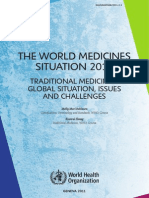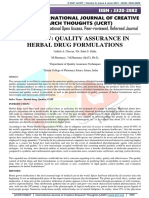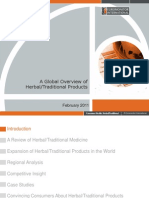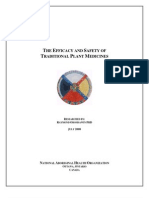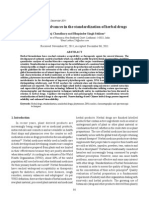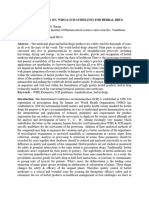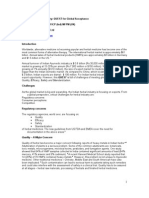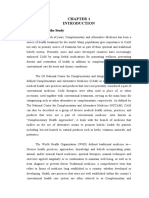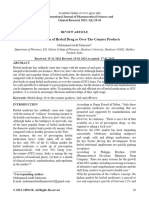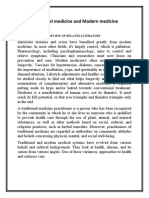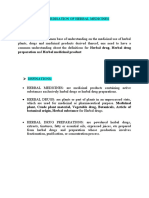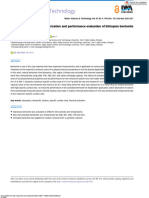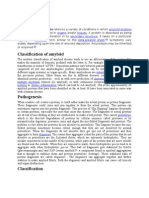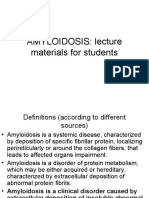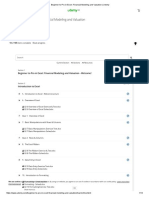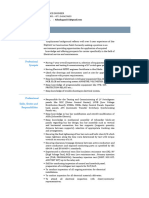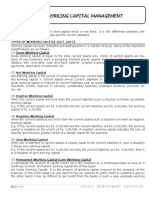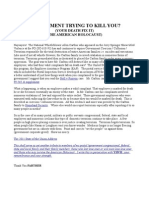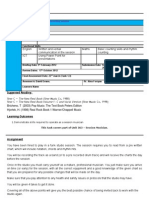PRev 6 154
PRev 6 154
Uploaded by
gechanatomyCopyright:
Available Formats
PRev 6 154
PRev 6 154
Uploaded by
gechanatomyOriginal Title
Copyright
Available Formats
Share this document
Did you find this document useful?
Is this content inappropriate?
Copyright:
Available Formats
PRev 6 154
PRev 6 154
Uploaded by
gechanatomyCopyright:
Available Formats
PHCOG REV.
REVIEW ARTICLE
Legal regulations of complementary and alternative
medicines in different countries
Ajazuddin, Shailendra Saraf
University Institute of Pharmacy, Pt. Ravi Shankar Shukla University, Raipur, Chhattisgarh, India
Submitted: 25-03-2011 Published: 23-08-2012
ABSTRACT
Traditional medicines that formed the basis of health care throughout the world since the earliest days of mankind are
still widely used and have considerable importance in international trade. Recognition of their clinical, pharmaceutical, and
economic value is still growing, although this varies widely between countries and therefore regulation of exploitation and
exportation is essential, together with international cooperation and coordination for their conservation so as to ensure
their availability for the future. World Health Organization and European Union issued the guidelines defined the basic
criteria for the evaluation of quality, safety, and efficacy of herbal medicines with the goal of assisting national regulatory
authorities, scientific organizations, and manufacturers in assessing documentation, submissions, and dossiers in respect
of such products. Legislative controls in respect of medicinal plants have not evolved around a structured control model.
There are different ways in which countries define medicinal plants or herbs or products derived from them. The present
review highlights the status of different countries adopted various approaches to licensing, dispensing, manufacturing,
and trading to ensure their safety, quality, and efficacy.
Key words: Efficacy, legislation, quality, safety, traditional medicines
INTRODUCTION hit US$ 5 trillion by 2050. The market is growing at 7% per annum
(The Times of India, 7-4-2000).
During the past decade, complementary and alternative medicines
A common feature of most systems of traditional medicine
have become a topic of global importance. Current estimates
(TM)/complementary and alternative medicine (CAM) is
suggest that in many developing countries, a large proportion
that they take a holistic approach to promote health, prevent
of the population relies heavily on traditional practitioners and
disease, and help the individual treat disturbances by regulating
medicinal plants to meet primary healthcare needs. Although
his/her physical, emotional, and mental aspects and living
modern medicine may be available in these countries, herbal
environment. According to its characteristics and concepts,
medicines (phytomedicines) have often maintained popularity
TM/CAM can be used not only for curing disease and relieving
for historical and cultural reasons. Concurrently, many people
symptoms but also for the regulation, improvement, and
in developed countries have begun to turn to alternative or
promotion of the function of the human body. Few plant
complementary therapies, including medicinal herbs. World Health
species that provide medicinal herbs have been scientifically
Organization (WHO) estimated that the world market for herbal
evaluated for their possible medical application. Safety and
medicines and herbal products is worth US$ 62 billion and would
efficacy data are available for even fewer plants, their extracts
and active ingredients, and the preparations containing them.
Address for correspondence: Furthermore, in most countries the herbal medicines’ market
Mr. Ajazuddin,
University Institute of Pharmacy, Pt. RSU, Raipur, Chhattisgarh,
is poorly regulated, and herbal products are often neither
India.E-mail: write2ajaz@gmail.com registered nor controlled. Assurance of the safety, quality,
and efficacy of medicinal plants and herbal products has now
become a key issue in industrialized and in developing countries.
Access this article online
Both the general consumer and healthcare professionals need
Quick Response Code: Website: up-to-date, authoritative information on the safety and efficacy
www.phcogrev.com
of medicinal plants. With the widespread use of TM as well as
CAM and the rapid expansion of international herbal medicine
markets, the development of national policies and regulations
DOI:
10.4103/0973-7847.99950
on TM/CAM has become an important concern for both
health authorities and the public. Providers of TM/CAM,
154 Pharmacognosy Reviews | July-December 2012 | Vol 6 | Issue 12
Ajazuddin and Saraf: Legal regulations of complementary and alternative medicines in different countries
other healthcare professionals, and TM/CAM consumers Traditional Chinese medicine
alike are calling for regulations that can ensure the safety of Traditional Chinese medicine has been used by Chinese people
TM/CAM therapies and products, promote recognition of from ancient times. Although animal and mineral materials have
these systems and modalities, and further define their role in been used, the primary source of remedies is botanical. Of the
modern healthcare systems. National policies and regulations more than 12,000 items used by traditional healers, about 500
on TM/CAM could ensure the safety, quality, and efficacy of are in common use.[4] Botanical products are used only after
these therapies and products and function as important steps some kind of processing, which may include, for example,
toward integrative healthcare systems. However, relatively stir-frying or soaking in vinegar or wine. In clinical practice,
few countries have developed policies and regulations on traditional diagnosis may be followed by the prescription of a
TM/CAM so far. Only 25 of WHO’s 191 countries have a complex and often individualized remedy. Traditional Chinese
national policy on TM/CAM and only 64 countries regulate medicine is still in common use in China. More than half the
herbal medicines.[1] population regularly uses traditional remedies, with the highest
prevalence of use in rural areas. About 5000 traditional remedies
To assist countries in the development of TM/CAM policies and are available in China; they account for approximately one-fifth
regulations of herbal medicines, WHO has published a series of of the entire Chinese pharmaceutical market.[4]
technical guidelines and reviewed regulations on herbal medicines
in the document “Regulatory Situation of Herbal Medicines: Japanese TM
a Worldwide Review.”[2] The purpose of the document is to Many herbal remedies found their way from China into the
share national experience in formulating policies on traditional Japanese systems of traditional healing. Herbs native to Japan
medicinal products, introduce measures for their registration and were classified in the first pharmacopoeia of Japanese TM in
regulation, and facilitate information exchange on these subjects the ninth century.[5]
among Member States.
Indian TM
In present review, we have compiled name of various regulatory Ayurveda is a medical system primarily practised in India that
authorities made for herbal medicines in different countries with has been known for nearly 5000 years. It includes diet and herbal
their major responsibilities and year of establishment which remedies, while emphasizing the body, mind, and spirit in disease
will definitely help the new researchers working in the field of prevention and treatment.[6]
quality control and standardization of TM/CAM.
The role of herbal medicines in traditional healing WHO GUIDELINES FOR HERBAL MEDICINES
The pharmacological treatment of disease began long ago with
the use of herbs.[3] Methods of folk healing throughout the These guidelines recognized the importance of herbal
world commonly used herbs as part of their tradition. Some medicines to the health of many people throughout the world,
of these traditions are briefly described below, providing some stating: “A few herbal medicines have withstood scientific
examples of the array of important healing practices around testing, but others are used simply for traditional reasons to
the world that used herbs for this purpose.[4] protect, restore, or improve health.” Most herbal medicines
Table 1: Different WHO guidelines with their major resolutions and year of establishment
WHO guidelines Major resolutions taken Year Ref
Quality control methods for medicinal plant Emphasized the need to ensure the quality of medicinal plant products 1998 [7]
materials by using modern control techniques and include suitable standards and
limits for contaminants are included.
WHO guidelines on safety monitoring of Provide technical guidance on the principles of good pharmacovigilance 2004 [8]
herbal medicines in pharmacovigilance and the inclusion of herbal medicines in existing national drug safety
systems monitoring systems.
Guidelines for the Regulation of Herbal This guideline aims to facilitate the registration and regulation of herbal 2003 [9]
Medicines in the South-East Asia Region medicines by establishing the foundation for a harmonized regulatory
standard to meet the common demands of the region.
General Guidelines for Methodologies on Harmonize the use of certain accepted and important terms in TM, 2000 [10]
Research and Evaluation of Traditional summarize key issues for developing methodologies for research and
Medicine evaluation of TM, improve the quality and value of research in TM, and
provide appropriate evaluation methods to facilitate the regulation and
registration of TMs.
National policy on TM and regulation of herbal Main objectives of this report are framing policy for safety, efficacy, and 2005 [11,12]
medicines Report of a WHO global survey quality of herbal medicines and its promoting rational use.
WHO guidelines on good agricultural and Quality assurance of medicinal plant materials used as the source 2003 [13]
collection practices for medicinal plants for herbal medicines, and encourage and support the sustainable
cultivation and collection of medicinal plants of good quality.
Pharmacognosy Reviews | July-December 2012 | Vol 6 | Issue 12 155
Ajazuddin and Saraf: Legal regulations of complementary and alternative medicines in different countries
Table 2: Legal status of different countries for herbal drug regulation
Country Legal status/policy Major responsibilities Year of Ref
establishment
Australia Therapeutic Goods Act The overall objective of the Act is to ensure the quality, safety, and 1989 [16,17]
(Commonwealth of Australia, efficacy of therapeutic goods, including medicines and medical
2001a) devices available to the Australian public.
Argentina Health Ministry of the Provincia Regulation for registration and commercialization of medicinal 1993 [18]
de Buenos Aires plants.
Austria Herbal medicine regulation Marketing authorizations. 1989 [19, 20]
Law No.541 Issuing of license.
Belgium Ministry of Health Under the law, proof of quality, safety, and efficacy became an 1995 [21-23]
essential precondition for the registration of drugs.
Canada Natural Health Products Ensure that the herbal medicinal plant product is safe under the 2004 [24-27]
Regulations recommended conditions of use without a prescription, effective
for the proposed claims, and of high quality.
Chile Unidad de Medicina Tradicional Incorporating TM with proven efficacy into health programs and 1992 [28]
of contributing to the establishment of their practice.
China The Drug Administration Law Encourages the development of both modern and traditional 1984 [18]
ofthe People’s Republic of China drugs, protects the resources of wild herbal drugs, and
promotes domestic cultivation of herbal drugs.
Colombia Ministry of Health Issuing of license. 1990 [29]
Documentation on the manufacturing process, quality control,
and, if necessary, toxicity studies.
Denmark Danish Ministry of Health Order Proof of quality, safety, and efficacy must be given; a 1992 [30, 31]
No. 790 bibliographic application with respect to therapeutic use is
accepted if it contains descriptions in the relevant scientific
literature of Europe or North America.
Egypt National Applied Research Medical, health, and nutrient content claims made by law. 1995 [18]
Centre for Medicinal Plants and Rules of GMP are implemented for herbal medicines.
National Organization for Drug
Control and Research
Estonia Medicinal Products Act To maintain the documents concerning chemical, 1996 [32]
pharmaceutical, biological, pharmacological-toxicological, and
clinical information of the herbal drugs.
Fiji Pharmacy and Poisons Act of Fiji Permits importation of TMs for use by ethnic communities 1994 [33,34]
Finland Administrative regulation 9/93 Quality and manufacture of herbal remedies 1993 [35]
(Marketing Authorization, 1993)
France French Medicines Agency Marketing authorizations [36]
Germany Medicines Act of 24 August 1976 Herbal finished drugs have to comply with the same criteria for 1976 [37-39]
quality, safety, and efficacy as all other finished drugs
Greece Ministry of Health Issuing of license, documentation on the manufacturing 1994 [40]
process, and toxicity studies.
Hungary Law on Public Health, Chapter Herbal drugs regulated as over the counter medicines for self- 1996 [41]
IV, Section 104 medication purposes and by law, medical claims, and health
claims may be made.
India Drugs and Cosmetics Act of 1940 Regulate the import, manufacture, distribution, and sale of 1945 [42]
and the Drugs and Cosmetics drugs and cosmetics.
Rules of. 1945
Indonesia Directorate of Traditional Drug Production, distribution and labeling of traditional drugs, and 1975 [18]
Control licensing of traditional drugs and imported traditional drugs.
Ireland Guidelines for Application for Licensing of manufacturers and authorization of herbal products 1985 [43,44]
Product Authorization of Herbal
Products" issued by National
Drugs Advisory Board
Italy Italian Health Authority Grant licensed and ensure the quality, safety, and efficacy. 1981 [45]
Japan Ministry of Health and Welfare Improve quality control of Kampo drugs 1972 [46]
Korea The Ministry of Public Health and Regulate and rule on the herbal medicines and their 1969 [47-50]
Social Affairs preparations.
Malaysia National Pharmaceutical Control Manufacturing, import, supply, or sailing of the TMs. [18]
Bureau, Ministry of Health
Mali Traditional Medicine Department Postmarketing surveillance and adverse effect monitoring of 1968 [18]
under the Ministry of Health herbal medicines.
Table 2 Contd.
156 Pharmacognosy Reviews | July-December 2012 | Vol 6 | Issue 12
Ajazuddin and Saraf: Legal regulations of complementary and alternative medicines in different countries
Table 2: Legal status of different countries for herbal drug regulation
Country Legal status/policy Major responsibilities Year of Ref
establishment
Mongolia Traditional Medicine Department Production, development, and investigation of TMs. 1989 [51]
under Mongolian National
Medical University
Nepal Department of Drug Price approval, safety, efficacy, and quality of products. 1996 [52]
Administration under the Ministry Authorization for import, export, and distribution of the product,
of Health and the mode of distribution and promotion.
New Medicines Act of 1981 Control of active ingredients and excipients, method of 1981 [18]
Zealand manufacture, control tests of the finished product, labeling,
stability, etc.
Nicaragua The national pharmaceuticals Safety assessment 1998 [53]
law-292
Oman Ministry of Health Grant of license for manufacturing and import permission 1995 [54]
Pakistan The Drugs Act of 1962 Controls the regulation of herbal medicines as regards 1962 [18]
advertising and prevention of misuse
Portugal Portugal Drug Act Regulation of herbal medicines in the same laws as those 1995 [55]
covering conventional pharmaceuticals.
Qatar Ministry of Public Health By law, medical, health, nutrient content, and structure/function 1990 [56]
claims may be made about herbal medicines.
Saudi Ministry of Health, KSA Medical, health, nutrient content, and structure/function claims 1996 [18]
Arabia may be made
Singapore Traditional Chinese Medicine Marketing authorization and licensing of manufacturers. 2000 [57,58]
Practitioners Act
South Medicines Control Council Safety assessment requirements include traditional use without 1994 [2]
Africa (MCC)/ Dietary Supplement demonstrated harmful effects, reference to documented
Health and Education Act of scientific research on similar products, and clinical data.
Spain The Spanish Medicinal Products Objective of the Act is to ensure the quality, safety, and efficacy 1990 [59, 60]
Act No. 25 of therapeutic goods, including herbal medicines.
The Swiss Agency for Marketing authorization. And implementation of GMP rules. 2002 [61]
Switzerland Therapeutic Products
(Swissmedic) under Federal
Department of Home Affairs
Thailand The Drug Act B.E. 2510 Premarketing control, licensing and registration process, and 1967 [18]
postmarketing control by quality control analysis.
United Medicines and Healthcare Postmarketing surveillance 1968 [62-66]
Kingdom products Regulatory Agency Licensed medicinal products require evidence of quality, safety,
(MHRA) and Medicines Act 1968 and efficacy and are regulated by the Medicines
Control Agency.
United Food Drug and Cosmetics Act Ensuring that a dietary supplement is safe before it is 2000 [67-70]
States Dietary Supplement Health and marketed, and the United States Food and Drug Administration 1994
Education Act is responsible for taking action against any unsafe dietary
supplement product after it reaches the market.
still need to be studied scientifically, although the experience The below mentioned WHO guidelines [Table 1] stressed the
obtained from their traditional use over the years should not need for assessment of efficacy including the determination of
be ignored. As there is not enough evidence produced by pharmacological and clinical effects of the active ingredients,
common scientific approaches to answer questions of safety cultivation and collection of the medicinal plants, and labeling
and efficacy about most of the herbal medicines now in use, which includes a quantitative list of active ingredient, dosage,
and contraindications.
the rational use and further development of herbal medicines
will be supported by further appropriate scientific studies of
these products, and thus the development of criteria for such THE EUROPEAN UNION
studies. In this regard, WHO has issued guidelines for the
The European Pharmacopoeia was created in 1964; its efforts
assessment of herbal medicines. These guidelines defined the
have resulted in the creation of 83 monographs on herbal drugs
basic criteria for the evaluation of quality, safety, and efficacy of that are used either in their natural state after desiccation or
herbal medicines with the goal of assisting national regulatory concentration or for the isolation of natural active ingredients.
authorities, scientific organizations, and manufacturers in The Association of the European Self-Medication Industry
assessing documentation, submissions, and dossiers in respect has carried out a study for the European Commission on
of such products. herbal medicinal products in the European Union (EU). The
Pharmacognosy Reviews | July-December 2012 | Vol 6 | Issue 12 157
Ajazuddin and Saraf: Legal regulations of complementary and alternative medicines in different countries
following summary is taken from this report.[14] The importance medicinal plants themselves and the products derived from
of herbal medicinal products varies from one country to them. Regulations in countries for the assessment of the quality,
another. These products are not a homogeneous group. In safety, and efficacy of medicinal plants, and the work of WHO
general, they are either fully licensed medicinal products and EU in supporting the preparation of model guidelines
with efficacy proven by clinical studies or by references to in this field, have been helpful in strengthening recognition
published scientific literature (in accordance with Article 4.8 of their role in health care. It is hoped that assessment of
a (ii) of Council Directive 65/65/EEC)[15] or are available these traditional remedies could become the basis for a future
as products with a more or less simplified proof of efficacy classification of herbal medicines, as well as for evaluative
according to their national use. Many Member States have studies on their efficacy and safety, and their potential use in
these two categories, but there are major discrepancies between national healthcare systems in different parts of the world.
the Member States in the classification of individual herbal
drug preparations and products into one of these categories
as well as in the requirements for obtaining a marketing AKNOWLEDGEMENT
authorization. According to Council Directive 65/65/EEC,[15]
The authors acknowledge the University Grant Commission
which has been implemented in national law in all Member [F. No. 34-131/2008 (SR)], New Delhi, India, for financial support.
States, medicinal products require prior marketing approval
before gaining access to the market. In almost all Member
States, herbal medicinal products are considered as medicinal
REFERENCES
products and are, in principle, subject to the general regulations
for medicines as laid down in the various national medicine 1. World Health Organization. Research Guidelines for Evaluating
laws. In many cases, a specific definition of herbal medicinal the Safety and Efficacy of Herbal Medicines. Manila: 1993.
products is available, which is in line with the EU Guideline 2. World Health Organization. Regulatory Situation of Herbal
“Quality of Herbal Medicinal Products.” This includes plants, Medicines. A Worldwide Review (WHO/trm/98.1). Geneva, 1998.
parts of plants, and their preparations, mostly presented with 3. Schulz V, Hänsel R, Tyler VE. Rational Phytotherapy. A Physician’s
therapeutic or prophylactic claims. Different categories of Guide to Herbal Medicine. 4th ed. Berlin: Springer; 2001.
medicinal products containing plant preparations exist or are 4. Li L. Opportunity and challenge of traditional Chinese medicine
in face of the entrance to World Trade Organization. Chin Inform
in the process of being created. For instance, draft legislation trad Chin Med 2000;7:7-8.
in Spain includes the definitions “herbal medicinal products” 5. Saito H. Regulation of herbal medicines in Japan. Pharmacol
and “phytotraditional products.” The latter are not considered Regul 2000;41:515-9.
as “pharmaceutical specialties” and are therefore not classified 6. Morgan K. Medicine of the Gods: Basic Principles of Ayurvedic
as herbal medicinal products. Medicine, 2002. Available from: http://www.compulink.co.uk/
mandrake/ayurveda.htm. [Last accessed on 2010 Jul 02].
7. World Health Organization. Regulatory Situation of Herbal
Legal status of different countries for herbal drug
Medicines. A Worldwide Review. Geneva: World Health
regulation Organization; 1998.
Legislative controls in respect of medicinal plants have not 8. World Health Organization. Guidelines on safety monitoring of
evolved around a structured control model. There are different herbal medicines in pharmacovigilance systems 2004.
ways in which countries define medicinal plants or herbs or 9. World Health Organization. Guidelines for the Regulation of
products derived from them, and countries have adopted Herbal Medicines in the South-East Asia Region. 2003.
various approaches to licensing, dispensing, manufacturing, 10. World Health Organization. General guidelines for methodologies
and trading to ensure their safety, quality, and efficacy, and due on research and evaluation of traditional medicine. Geneva:
WHO; 2000.
to these reasons herbal preparations varies from country to
11. World Health Organization. National policy on traditional
country. In some, phytomedicines are well established, whereas medicine and regulation of herbal medicines Report of a WHO
in others they are regarded as food and therapeutic claims are global survey 2005.
not allowed. This article follows a generalized template that 12. World Health Organization. Traditional Medicine Strategy.
includes regulatory authorities of various countries and their 2002–2005.
major responsibilities with year of establishment [Table 2]. 13. World Health Organization. Guidelines on good agricultural and
collection practices (GACP) for medicinal plants. 2003.
14. AESGP (Association Européenne des Spécialités
CONCLUSION Pharmaceutiques Grand Public; The Association of the
European Self-Medication Industry) 1998.
The growth of the pharmaceutical industry and the unceasing 15. European Commission Council Directive 65/65/EEC on the
approximation of provisions laid down by Law, Regulation or
development of new and more effective synthetic and biological Administrative Action relation to proprietary medicinal products.
medicinal products have not diminished the importance of Off J 1965;22:369-73.
medicinal plants in many societies. On the contrary, population 16. Briggs DR. The regulation of herbal medicines in Australia.
growth in the developing world and increasing interest in the Toxicology 2002;181-182:565-70.
industrialized nations have greatly expanded the demand for 17. Therapeutic Goods Administration Medicines Regulation and
158 Pharmacognosy Reviews | July-December 2012 | Vol 6 | Issue 12
Ajazuddin and Saraf: Legal regulations of complementary and alternative medicines in different countries
the TGA. Woden, ACT, Australia; 1999. 41. Association of European Self-Medication Consumer (AESGP),
18. Xiaorui Z. Regulatory situation of herbal medicines: A worldwide editor. Economic and Legal Framework for Non-Prescription
review. Tradit Med Program 1998;1-45. Medicines in Europe. Brussels: AESGP,1996. p. 105-9.
19. Regulation of the Minister of Health, Sports and Consumer 42. Drug and cosmetic act, Government of India.1942.
Protection, the Regulation concerning facilitation of the 43. Morris JM. Communication of the Irish Medicines Board with
admission of certain Medicinal products is changed. Federal World Health Organization; 1996.
Law Gazette Republic of Austria, 1992, 3912-5. 44. Guidelines for Application for Product Authorization of Herbal
20. Regulation of the Minister for Health and Public Service and Products. Dublin: National Drugs Advisory Board; 1985.
the Federal Minister for Economic Affairs of 21 November 1989 45. Prodotti a base di piante medicinali. Circolare n. 1 (N.
on the tax and labeling of certain drugs in the retail selling 800.7.AG.8/254). Direzione Generale del Servizio Farmaceutico
(Delimitation Regulation). Federal Law Gazette of the Republic Divisione VII; 1981.
Austria, 1989; 4049-78.
46. Eguchi K, Hyodo I, Saeki H. Current status of cancer patients’
21. Sofia, Bulgaria; Information letter of the Ministry of Health, perception of alternative medicine in Japan. A preliminary cross-
National Drug Institute. dated 1996 Feb 07. sectional survey. Support Care Cancer 2000;8:28-32.
22. Ministry of Public Health and Environment. Ministerial circular 47. Choi DW, Kim JH, Cho SY, Kim DH, Chang SY. Regulation and
instructions to the constitution of the file registration of herbal quality control of herbal drugs in Korea. Toxicology 2002;181-
medicines. monitor Belgian 1995 and 3103-9. 182:581-6.
23. Ministry of Public Health and Environment. Circular Ministerial 48. Bonati A. Guidelines for the chemical and biological assessment
nE 367, 1989. of herbals and herbal preparations UNIDO. 1989;1-18 .
24. Jordan SA, Cunningham DG, Marles RJ. Assessment of herbal 49. Korean Pharmacopoeia. 7th ed. Seoul, Korea: Medicine
medicinal products: Challenges, and opportunities to increase Publishers; 1997.
2 the knowledge base for safety assessment. Toxicol Appl
50. Korean Herbal Pharmacopoeia. Korea: Ministry of Health and
Pharmacol 2010:243:198-216.
Welfare; 1987.
25. Johnson T. Chinese medicine now part of primary care scene in
51. Ministry of Health Traditional Mongolian Medicine. Information
BC. CMAJ 2001;164:1195.
sheet. Mongolia;1996.
26. Sibbald B. New federal office will spend millions to regulate
52. Gewali MB. Personal communication 1995 Nov 16.
herbal remedies, vitamins. CMAJ 1999;160:1355-7.
53. Sotomayor U. Traditional Medicine in Nicaragua and its
27. Kozyrskyj A. Herbal products in Canada. How safe are they. Can
Integration into the Local Health Systems. Lecture held at the
Fam Physician. 1997;43:697-702.
Morris Arboretum Symposium. Philadelphia, 1993 Apr 19-21.
28. Calixto JB. Efficacy, safety, quality control, marketing and
54. Ministry of Health of the Sultanate of Oman. Conditions to allow
regulatory guidelines for herbal medicines (phytotherapeutic
import of traditional drugs. Muscat; 1995.
agents). Braz J Med Biol Res 2000;33:179-89.
55. The flour, Cachadinha M. Some considerations on the
29. Ministry of Health of the Republic of Colombia resolution
Portuguese legislation, Herbal Medicine. LEF in July 1994. 2
Number 1990.
56. World Health Organization Guidelines for the Assessment of
30. Order on herbal medicines. Ministry of Health. No. 1992; 790.
Herbal Medicines (WHO Technical Report Series No. 863).
31. NLN Regulatory Seminars in Quality Assessment of Natural Geneva: WHO; 1996.
Remedies. NLN Publication No. 40. Uppsala: Nordic Council on
57. World Health Organization Western Pacific Regional Office
Medicines; 1996.
(WPRO). 1996.
32. Procedure for registration of medicinal products and approval
58. Pharmaceutical Department of the Ministry of Health of
of variations to the terms of registered medicinal products.:
Singapore. Communication with WHO 1996 Mar 13.
Estonia; 1996.
59. Des Medicines Act, Madrid, Art 42.Ley25/1990.
33. Bailey M. Communication of the Ministry of Health, Suva, Fiji,
with World Health Organization. 1996. 60. Order of October 3, 1973 by establishing the record special
preparations of vegetables species medicinal. Ministry of the
34. The NSW Therapeutic Medicines Information Centre. The
Interior. BOE 247 of 15 nE October, Madrid, 1973.
uncertain world of "herbal" medication - A drug information
viewpoint. Drug Bull 1993;19. 61. Communications from the ICS. ICS monthly report of Bern,
1992;6:345.
35. Commission Directive 91/507/EEC of 19 July 1991 modifying the
Annex to Council Directive 75/318/EEC on the approximation 62. Griffin JP. The evolution of human medicines control from a
of the laws of Member States relating to analytical, national to an international perspective. Adverse Drug React
pharmacotoxicological and clinical standards and protocols in Toxicol Rev 1998;17:19-50.
respect of the testing of medicinal products. Official Journal of 63. Ministry of Agriculture, Fisheries and Food (MAFF) Herb
the European Communities nE L. 270/32 of 26 Sept 1991. Legislation. London: Herb Society; 1998.
36. Castot A, Djezzar S, Deleau N, Guillot B, Efthymiou ML. Drug 64. Mills SY. The House of Lords report on complementary medicine:
surveillance of herbal medicines. Thérapie 1997;52:97-103. A summary. Complement Ther Med 2001;9:34-9.
37. Kraft K. Herbal medicine products and drug law. Forsch 65. Shaw D. Risks or remedies? Safety aspects of herbal remedies.
Komplementärmed 1999;6:19-23. J R Soc Med 1998;91:294-6.
38. Sandberg F, Corrigan D. Natural remedies. Their Origins and 66. De Smet PA. Should herbal medicine-like products be licensed
Uses, New York: Taylor and Francis; 2001. as medicines. BMJ 1995;310:1023-4.
39. Keller K. Legal requirements for the use of phytopharmaceutical 67. Chang J. Scientific evaluation of traditional Chinese medicine
drugs in the Federal Republic of Germany. J Ethnopharmacol under DSHEA: A conundrum. Dietary Supplement Health and
1991;32:225-9. Education Act. J Altern Complement Med 1999;5:181-9.
40. Minister of health, providence and social insurance regulation. 68. Angell M, Kassirer JP. Alternative medicine-the risks of untested
Ankara. 1994. and unregular remedies. N Engl J Med 1998;339:839-41.
Pharmacognosy Reviews | July-December 2012 | Vol 6 | Issue 12 159
Ajazuddin and Saraf: Legal regulations of complementary and alternative medicines in different countries
69. Goldman SA, Kennedy DL. FDA’s Medical Products Reporting How to cite this Article: A, Saraf S. Legal regulations of
Program. A joint effort toward improved public health. Postgrad complementary and alternative medicines in different countries.
Med 1998;103:13-6. Phcog Rev 2012;6:154-60.
70. Food and Drug Administration, Guidance for Industry: Botanical Source of Support: University Grant Commission [F. No. 34-
Drug Products, Washington DC, Center for Drug Evaluation 131/2008 (SR)], New Delhi, India,, Conflict of Interest: None
and Research 2000. Available from: http://www.fda.gov/cder/ declared
guidance/index.htm [Last accessed on 2010 Jul 02].
AUTHOR INSTITUTION MAP FOR THIS ISSUE
Map will be added after issue gets online****
Please note that not all the institutions may get mapped due to non-availability of requisite information in Google Map. For AIM of other issues, please check
Archives/Back Issues page on the journal’s website.
160 Pharmacognosy Reviews | July-December 2012 | Vol 6 | Issue 12
You might also like
- Neurology LocalizationDocument6 pagesNeurology LocalizationPramod ThapaNo ratings yet
- AHCC: The Medical Breakthrough in Natural ImmunotherapyFrom EverandAHCC: The Medical Breakthrough in Natural ImmunotherapyRating: 5 out of 5 stars5/5 (1)
- Ark AngelDocument172 pagesArk AngelCrina Serban67% (6)
- Math 143C GreensheetDocument3 pagesMath 143C GreensheetBobNo ratings yet
- Standardization of Herbal Medicines - A ReviewDocument12 pagesStandardization of Herbal Medicines - A Reviewxiuhtlaltzin100% (1)
- Available Online Through: Regulatory Status of Traditional Medicines in Africa RegionDocument0 pagesAvailable Online Through: Regulatory Status of Traditional Medicines in Africa RegionTrue BlissNo ratings yet
- WHO Concept Paper PDFDocument13 pagesWHO Concept Paper PDFMillenium AyurvedaNo ratings yet
- Tugas " Farmasi Komunitas Dan Klinis "Document20 pagesTugas " Farmasi Komunitas Dan Klinis "Icha FebrianiNo ratings yet
- HerbalDocument13 pagesHerbalronny nyagakaNo ratings yet
- Challenges and Issues Related To Regulation of Traditional MedicineDocument41 pagesChallenges and Issues Related To Regulation of Traditional MedicineKavish BhajbhujeNo ratings yet
- The Use of Herbal Medicines in Primary Health CareDocument66 pagesThe Use of Herbal Medicines in Primary Health Carerodasbiz100% (1)
- Samarth WordDocument15 pagesSamarth WordSamarth ShuklaNo ratings yet
- Drug Interactions With Herbal MedicinesDocument10 pagesDrug Interactions With Herbal MedicinesKevin Ernesto Custodio MartinezNo ratings yet
- Consumer BehaviourDocument196 pagesConsumer BehaviourMohd MohsinNo ratings yet
- Final Project Mahesh TejasDocument32 pagesFinal Project Mahesh TejasNeuronNo ratings yet
- The World Medicines Situation 2011 Traditional Medicines - Global Situation, Issues and ChallengesDocument14 pagesThe World Medicines Situation 2011 Traditional Medicines - Global Situation, Issues and ChallengesBlogWatchNo ratings yet
- IJCRT2106647Document10 pagesIJCRT2106647Darshan RNo ratings yet
- Rankoana SA 2012 PDFDocument238 pagesRankoana SA 2012 PDFNica DesateNo ratings yet
- A Global Overview of Herbal-Traditional ProductsDocument52 pagesA Global Overview of Herbal-Traditional ProductsMary Barker100% (2)
- Week 2 Pharmaceutical Marketing and Entrepreneurship: (Lecture)Document5 pagesWeek 2 Pharmaceutical Marketing and Entrepreneurship: (Lecture)Jada ShblNo ratings yet
- An Overview of Herbal MedicineDocument19 pagesAn Overview of Herbal Medicinesatyampandit806No ratings yet
- Review: Recent Approaches in Herbal Drug StandardizationDocument9 pagesReview: Recent Approaches in Herbal Drug Standardizationkj0203No ratings yet
- Efficacy & Safety of Trad Plant MedicinesDocument41 pagesEfficacy & Safety of Trad Plant MedicinesBiol. Miguel Angel Gutiérrez DomínguezNo ratings yet
- Efficacy & Safety Traditional Plant MedicinesDocument50 pagesEfficacy & Safety Traditional Plant MedicinesRaymond ObomsawinNo ratings yet
- Guidelines For The Regulation of Herbal Medicines in The South-East Asia RegionDocument65 pagesGuidelines For The Regulation of Herbal Medicines in The South-East Asia RegionRaisa FebriyaNo ratings yet
- 3157 3632 1 PB PDFDocument9 pages3157 3632 1 PB PDFayuNo ratings yet
- Mono82 6ADocument26 pagesMono82 6Amanmohitsinghkahlon123No ratings yet
- An Overview On Herbal Medicine: Research Journal of Pharmacognosy and Phytochemistry January 2019Document5 pagesAn Overview On Herbal Medicine: Research Journal of Pharmacognosy and Phytochemistry January 2019FaizNo ratings yet
- Integration of Herbal Medicine in GhanaDocument4 pagesIntegration of Herbal Medicine in GhanakofinyameNo ratings yet
- Bioactive Medicinal Plants - D. Hota (Gene-Tech, 2007) WWDocument277 pagesBioactive Medicinal Plants - D. Hota (Gene-Tech, 2007) WWAlexandra Maris75% (4)
- Bioactive Compounds in Phytomedicine BookDocument228 pagesBioactive Compounds in Phytomedicine BookAnil KumarNo ratings yet
- An Overview of Advances in The Standardization of Herbal DrugsDocument16 pagesAn Overview of Advances in The Standardization of Herbal DrugsVishal Jogi100% (2)
- Lecture 2 - Mainstreaming Traditional Medicine in Pubic Health Discourse - EditedDocument39 pagesLecture 2 - Mainstreaming Traditional Medicine in Pubic Health Discourse - EditedofficialmwalusambaNo ratings yet
- A REVIEW STUDY ON PPDocument6 pagesA REVIEW STUDY ON PPStockerMarketNo ratings yet
- RRLDocument4 pagesRRLkennethjames.lagmanNo ratings yet
- Lifestlyee DrugsDocument3 pagesLifestlyee DrugsZulfkar Latief QadrieNo ratings yet
- Herbal Meds JournalDocument10 pagesHerbal Meds Journalnicole alignoNo ratings yet
- Tripathi Rational Use of DrugsDocument39 pagesTripathi Rational Use of DrugsTaimoor AbdullahNo ratings yet
- Literature Review On Otc DrugsDocument6 pagesLiterature Review On Otc Drugsafmzsawcpkjfzj100% (1)
- Herb-Drug Interaction in Inflammatory Diseases RevDocument31 pagesHerb-Drug Interaction in Inflammatory Diseases RevartycheyartyNo ratings yet
- Fundamentals of PhytotherapyDocument60 pagesFundamentals of Phytotherapya791699141No ratings yet
- An In-Depth-Study of OTC Medicine Segment of Indian Pharmaceutical Industry With SpecialDocument194 pagesAn In-Depth-Study of OTC Medicine Segment of Indian Pharmaceutical Industry With SpecialJnany AppuNo ratings yet
- Project ON Nutraceuticals-'Foods As Medicine': Submitted ToDocument15 pagesProject ON Nutraceuticals-'Foods As Medicine': Submitted ToRahul Abhishek MehraNo ratings yet
- Opportunities For Export of Ayurvedic Products To African CountriesDocument12 pagesOpportunities For Export of Ayurvedic Products To African CountriesTAJ26No ratings yet
- Challenges For Ayurvedic IndustryDocument5 pagesChallenges For Ayurvedic IndustryAjay AswaniNo ratings yet
- PV of Herbals 34Document1 pagePV of Herbals 34rr48843No ratings yet
- 03 BodyDocument81 pages03 BodyAnonymouscatNo ratings yet
- Pharmacovigilance Paper PDFDocument19 pagesPharmacovigilance Paper PDFHassan Ahmed KhanNo ratings yet
- 8-4-205-517 - Efektivitas ObaDocument4 pages8-4-205-517 - Efektivitas ObaMeiyanti MeiyantiNo ratings yet
- Devi Datt Joshi Auth. Herbal Drugs and Fingerprints Evidence Based Herbal DrugsDocument261 pagesDevi Datt Joshi Auth. Herbal Drugs and Fingerprints Evidence Based Herbal DrugsStella AguirreNo ratings yet
- Concept of Essential Drugs: Chapter-IDocument22 pagesConcept of Essential Drugs: Chapter-IVitalis MbuyaNo ratings yet
- Gacp WhoDocument80 pagesGacp WhoGarnasih Putri RastitiNo ratings yet
- Ethics in Pharmaceutical IssuesDocument21 pagesEthics in Pharmaceutical IssuesAnaliza Kitongan LantayanNo ratings yet
- Overview of NutraceuticalsDocument8 pagesOverview of Nutraceuticalsmaria dulceNo ratings yet
- 03 Ijpscr 119 23Document18 pages03 Ijpscr 119 23BRNSS Publication Hub InfoNo ratings yet
- Traditional Medicine and Modern Medicine: Review of Related LiteratureDocument4 pagesTraditional Medicine and Modern Medicine: Review of Related LiteratureLen CyNo ratings yet
- Standardisation of Herbal MedicinesDocument9 pagesStandardisation of Herbal MedicinesVinita GaonkarNo ratings yet
- Herbal medicine: Herbal Antibiotics ,The Ultimate Guide Guide to Healing Common AilmentsFrom EverandHerbal medicine: Herbal Antibiotics ,The Ultimate Guide Guide to Healing Common AilmentsNo ratings yet
- The Psychopharmacology of Herbal Medicine: Plant Drugs That Alter Mind, Brain, and BehaviorFrom EverandThe Psychopharmacology of Herbal Medicine: Plant Drugs That Alter Mind, Brain, and BehaviorNo ratings yet
- Herbal Antivirals Book: The Ultimate Guide to Herbal Healing, Magic, Medicine, Antivirals, and AntibioticsFrom EverandHerbal Antivirals Book: The Ultimate Guide to Herbal Healing, Magic, Medicine, Antivirals, and AntibioticsNo ratings yet
- Regulatory Aspects of Pharmaceutical Quality System: Brief IntroductionFrom EverandRegulatory Aspects of Pharmaceutical Quality System: Brief IntroductionNo ratings yet
- Ethiopian BentoniteDocument11 pagesEthiopian BentonitegechanatomyNo ratings yet
- Eucalyptus OilDocument7 pagesEucalyptus OilgechanatomyNo ratings yet
- Clinical Anatomy of Upper Limb Joints and MusclesDocument92 pagesClinical Anatomy of Upper Limb Joints and Musclesgechanatomy100% (1)
- Cardiac Pathology 1:: Blood VesselsDocument72 pagesCardiac Pathology 1:: Blood VesselsgechanatomyNo ratings yet
- NHS Standard Service Level Specifications: Specific Service Specification - Materials Management ServiceDocument13 pagesNHS Standard Service Level Specifications: Specific Service Specification - Materials Management ServicegechanatomyNo ratings yet
- Amyloidosis WodDocument3 pagesAmyloidosis WodgechanatomyNo ratings yet
- AMYLOIDOSIS: Lecture Materials For StudentsDocument134 pagesAMYLOIDOSIS: Lecture Materials For StudentsgechanatomyNo ratings yet
- Circulatory ShockDocument1 pageCirculatory ShockgechanatomyNo ratings yet
- Mohandas Karamchand Gandhi Was Born On October 2Document3 pagesMohandas Karamchand Gandhi Was Born On October 2Ryan Tw ChoumingNo ratings yet
- Nature Book PDFDocument2 pagesNature Book PDFBharatiyulam100% (1)
- Draw PracticeDocument10 pagesDraw PracticeShacore BrownNo ratings yet
- Career Guidance SHS - 4exitsDocument59 pagesCareer Guidance SHS - 4exitschristian myles pascuaNo ratings yet
- Jobs and OccupationsDocument58 pagesJobs and OccupationsrubebpopsNo ratings yet
- Geomorphology of Desert Environ - A.J. Parsons PDFDocument824 pagesGeomorphology of Desert Environ - A.J. Parsons PDFMiguel Angel Catunta Zarate100% (2)
- (Vol II), 2019 Rules For Hull, 2019Document694 pages(Vol II), 2019 Rules For Hull, 2019Osvaldo SimanjuntakNo ratings yet
- ExclDocument14 pagesExclAdahylNo ratings yet
- 1 PDFDocument35 pages1 PDFabraha gebruNo ratings yet
- HealthEducation GuideBook SindhiDocument78 pagesHealthEducation GuideBook SindhinavalNo ratings yet
- Offshore201410 DL PDFDocument118 pagesOffshore201410 DL PDFRicardo FerreiraNo ratings yet
- 12th JULY TNA by Aditya SirDocument87 pages12th JULY TNA by Aditya SirSubhanshi VermaNo ratings yet
- Take Home Assignment CS2002Document2 pagesTake Home Assignment CS2002aliapple21661No ratings yet
- ARIVU QAQC ENG Curriculum VitaeDocument3 pagesARIVU QAQC ENG Curriculum Vitaearivazhaganverger2018No ratings yet
- Working Capital ManagementDocument38 pagesWorking Capital ManagementABHIJEIT BHOSALENo ratings yet
- Day of The Dead Comprehension Questions HADocument5 pagesDay of The Dead Comprehension Questions HAPaul EmmisonNo ratings yet
- 1.introduction To IEDocument16 pages1.introduction To IEManojNo ratings yet
- Air Handling Units: Technical CatalogDocument72 pagesAir Handling Units: Technical Catalogarindam02041985No ratings yet
- Kahoot! - WikipediaDocument41 pagesKahoot! - WikipediaWater ShurikenNo ratings yet
- Government Trying To Kill YouDocument3 pagesGovernment Trying To Kill YouAllen Carlton Jr.67% (3)
- DBMS M1 - Ktunotes - inDocument131 pagesDBMS M1 - Ktunotes - inexamlab57No ratings yet
- 363 Session Musicia N: Creative Arts & IndustriesDocument4 pages363 Session Musicia N: Creative Arts & Industriesdavebass66No ratings yet
- Africa Barometer: NamibiaDocument48 pagesAfrica Barometer: NamibiaAlice YangNo ratings yet
- Elektor 1997 01 PDFDocument74 pagesElektor 1997 01 PDFAdriano Andrade100% (1)
- Freedom WritersDocument2 pagesFreedom Writersliliana ursuNo ratings yet
- Cot TrendsDocument5 pagesCot TrendsCorrea JannelleNo ratings yet















